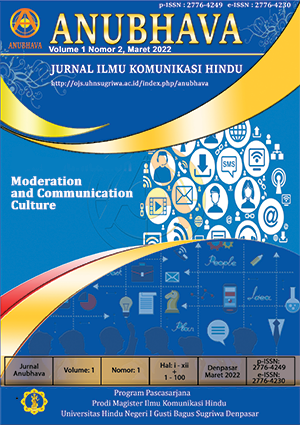SEKSUALITAS: MEDIA PEMUASAN HASRAT (PERSPEKTIF KOSMOLOGI HINDU)
DOI:
https://doi.org/10.25078/anubhava.v2i1.1049Keywords:
Keywords: Sexuality, Desire Satisfaction Media, Hindu Cosmology PerspectiveAbstract
Sexuality is a component of an individual's personal identity that is inseparable and develops and matures throughout an individual's life. Sexuality is not the same as sex. Sexuality is the interaction of biological factors, personal psychology, and the environment. Biological function refers to an individual's ability to give and receive pleasure and to reproduce. Psychological sexual identity and self-concept refer to an individual's inner understanding of sexuality such as self-image, identification as male or female, and learning of masculine or feminine roles. In writing this article, the method used is literature study by entering keywords on google.scholar.com and various other literature to support the references of this article. In addition, several articles and/or books related to this theme also support the completion of this article. Hindu cosmology is the concept of the creation of the universe and its contents, no less important in the concept of cosmology is sexuality and spirituality which are important and integrated dimensions, where through human sexuality, individuals can experience a direct erotic relationship with God and perform a new creation and continuously evolved to give birth to new genes/generations.
References
Bakker, Anton. 1995. Kosmologis dan Ekologi (Filsafat tentang Kosmos sebagai Rumah Tangga Manusia). Yogyakarta: Kanisius.
Departemen Pendidikan dan Kebudayaan. Kamus Besar Bahasa Indonesia. Jakarta: Balai Pustaka, 1987.
Desmita. 2009. Psikologi Perkembangan Peserta Didik. Bandung: Remaa Rosdakarya.
Donder, I Ketut. 2007. Virat Vidya: Kosmologi Hindu. Surabaya: Paramita.
Embriologi dalam Al-Qur’an: Kajian pada Proses Penciptaan Manusia. Malang: UIN Press
Hahhosseini, Z., Gardeshi, Z. H., Pourasghar, M., & Salehi, F. (2014). A review of affecting factors on sexual satisfaction in women. Mater Sociomed, 26(6), 378.
Hathaway Cooney Patricia. Sexuality and the Spiritual Life. Seminary Journal Theme: Human Formation in Light of John Jay Study. (2015): 32 – 37.
Heri Jauhari. 2010. Panduan Penulisan Skripsi Teori dan Aplikasi. Bandung: Pustaka Setia.
Kusuma, W. 2012. Resep Membuat Anak Laki-Perempuan menurut Hindu. Pustaka Bali Post. Denpasar.
Paririnder, Geoffrey. 2005. Teologi Seksual. Penerjemah Amirudin dan Asyhabuddin. Editor Rahmat Widada. Yogyakarta: Lkis Yogyakarta.
Rahmani, A., Khoei, E. M., & Gholi, L. A. (2009). Sexual Satisfaction and its Relation to Marital Happiness in Iranians. Iranian J Publ Health, 38(4), 77-82.
Samsul Bakri dan Udhofir, Jombang-Kairo, Jombang Chicago: Sintesis Pemikiran Gus Dur dan Cak Nur dalam Pembaharuan Islam di Indonesia (Solo: Tiga Serangkai, 2004), Cet. Ke-1, h. 49.
Shackelford, David, M. B., & Todd. (1997). Susceptibility to Infidelity in The First Year of Marriage. Journal of Research in Personality, 31(2), 193-221.
Wahid, Abdurrahman. Pergulatan Negara, Agama dan Kebudayaan. Depok: Desantara, 2001.
Wawan Kurniawan, “Menolak HAM atau Mengubah Fiqh: Pemikiran Gus Dur tentang Islam dan HAM,” Kajian Kebudayaan dan Demokrasi, Weltanscauung Gus Dur, Edisi. vi (Juni 2010),h. 40.
Yeh, Lorenz, F. O., Wicakrama, K. A., & Conger, R. D. (2006). Relationships among Sexual Satisfaction, Marital Quality, and Marital Instability at Midlife. Journal of Family Psychology 20(2), 339.
Sandhi, D.W.N. Kanda Pat, Perkembangan dan Pengaruhnya terhadap Manusia. Available at:http://www.babadbali.com/pustaka/ibgwdwidja/kandapat.htm (diakses pada tanggal 1 Mei 2022).
Downloads
Published
Issue
Section
License
Copyright (c) 2022 Anubhava: Jurnal Ilmu Komunikasi HIndu

This work is licensed under a Creative Commons Attribution-NonCommercial-NoDerivatives 4.0 International License.
Anubhava: Jurnal Komunikasi Hindu is licensed under a Creative Commons Attribution-ShareAlike 4.0 International License. Permissions beyond the scope of this license may be available at Anubhava: Jurnal Ilmu Komunikasi
















